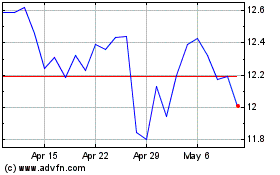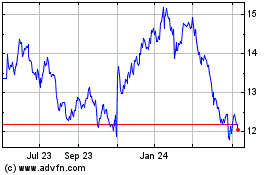Report Shows Non-Rugged Mobile Devices Fail
More than Three Times As Often As Rugged Devices, While Rugged
Devices Average 46 Percent Lower Total Cost of Ownership
According to a new study from Kyocera Communications Inc.,
non-rugged mobile devices fail more than three times as often as
rugged devices in business environments, while rugged devices
average 46 percent lower total cost of ownership. The study, which
was conducted by VDC Research and released today during APCO
International’s Annual Conference & Expo, polled more than 200
Information Technology decision makers across several industries –
including transportation, manufacturing, healthcare and hospitality
– to determine the most common causes of mobile-device failures and
which types of devices fail more often. It also explored the
“Cripple Ripple Effect,” or the impact a single device failure can
have on a company’s productivity and bottom line. For example,
according the study, each single device failure can cost an
organization 170 to 200 minutes in lost mobile-worker productivity
and internal support. The full report is available at
http://www.kyoceramobile.com/business.
This Smart News Release features multimedia.
View the full release here:
http://www.businesswire.com/news/home/20150817005210/en/
The introduction of rugged, affordable
smartphones like Kyocera's DuraForce, Brigadier and TorqueXT, along
with its Dura Series feature phones, is helping many companies
reduce the overall total cost of ownership and ensure the
productivity of their workforces. (Photo: Business Wire)
“Nearly 100 million mobile devices are expected to be used by
frontline mobile workers in 2015, and these survey results
underscore the need for further education on mobile-management
solutions to ensure the right device is in use,” said Eric Heiser,
vice president of corporate planning at Kyocera Communications.
“Many consumer devices aren’t designed for use in business
environments and the hardware is failing. In fact, it isn’t
uncommon for companies to report failure rates in excess of 50
percent. This is precisely why Kyocera brought its portfolio of
affordable, ruggedized smartphones and feature phones to the
enterprise market.”
The introduction of rugged, affordable smartphones like
Kyocera’s DuraForce, Brigadier and TorqueXT, along with its Dura
Series feature phones, is helping many companies reduce the overall
total cost of ownership and ensure the productivity of their
workforces. In fact, organizations using rugged smartphones
reported a total cost of ownership per phone 46 percent lower than
those using non-rugged smartphones.
“Mobile devices supporting various line-of-business workflows
are deemed business-critical, as workers cannot perform a majority
of their tasks should their devices fail,” said David Krebs,
executive vice president, Enterprise Mobility and AIDC at VDC
Research. “Thus, reliability is an absolute necessity with rugged
devices, providing the critical protection required for many of
these workers. The cost of failure – as expressed in lost
productivity, increased IT support requirements and the potential
for erosion of customer satisfaction and lost revenues – can be
significant and directly impact an organization’s operating
margins.”
Prices for Kyocera’s rugged devices are a fraction of those
charged for many enterprise-specific mobile devices, and Kyocera’s
rugged phones are conveniently stocked in stores by most of the
leading wireless service providers. Kyocera has a growing network
of hardware and software accessory providers and supports
enterprise mobility management (EMM) enhancements in security, VPN,
mobile device management (MDM) and Exchange ActiveSync (EAS). The
full portfolio of devices, along with accessory and
where-to-purchase information, is available at
http://www.kyoceramobile.com/business.
In smartphones, Kyocera offers the DuraForce, Brigadier and
TorqueXT. Rugged feature phones include the DuraXV, DuraXA and
DuraXT. Each device carries an IP certification for dust- and
waterproofing, along with a range of certified Military Standard
810G profiles. The smartphones use the Android™ operating system
and feature Qualcomm® Snapdragon™ processors. A leader in
push-to-talk (PTT)-enabled devices, Kyocera supports numerous
leading PTT platforms and many devices include front-facing 100dB+
extra-loud speakers and dedicated buttons for PTT or other
programmed apps. Along with their durable designs, Kyocera devices
have high-capacity batteries well suited to long days on the job
and can operate in extreme temperatures. Other available features
include touchscreen displays that can be used when wet or when
wearing gloves1 and expandable memory.
For hazardous work environments, Kyocera offers devices
certified for use where concentrations of flammable gases, vapors,
or mists are not normally present in an explosive concentration but
may materialize, making them well-suited for industries such as Oil
Exploration and Production, Utilities, Chemical Production, Airport
Refueling, Pharmaceutical/Paint Industries and Natural Gas
Pipeline/Production Centers. (Hazardous Locations: Non-incendive,
Class I, Division 2)
More information on Kyocera’s portfolio of durable and rugged
devices for business, along with accessory and where-to-purchase
information, is available at
http://www.kyoceramobile.com/business.
ABOUT KYOCERA COMMUNICATIONS INC.
Kyocera Communications, Inc. is the headquarters for
Kyocera-branded wireless devices in the Americas. It is part of the
global Kyocera Group, which was founded in 1959 and is a leading
supplier of telecommunications equipment, copiers, printers, solar
power generating systems, electronic components, semiconductor
packages, cutting tools and industrial ceramics. With a 56-year
history of quality and innovation, Kyocera is the U.S. market
leader in durable and waterproof mobile devices for consumers and
enterprises. Kyocera uniquely combines Military Standard
810G-certified ruggedization and enterprise-grade security and
application support with consumer-tier pricing and availability
from the nation’s leading wireless service providers. For more
information, follow the company at facebook.com/kyoceramobile
or twitter.com/kyoceramobile.
Kyocera Corporation (NYSE:KYO)(TOKYO:6971)
(http://global.kyocera.com/), the parent and global headquarters of
the Kyocera Group, was founded in 1959 as a producer of fine
ceramics (also known as “advanced ceramics”). By combining these
engineered materials with metals and integrating them with other
technologies, Kyocera has become a leading supplier of solar power
generating systems, mobile phones, printers, copiers, electronic
components, semiconductor packages, cutting tools and industrial
ceramics. During the year ended March 31, 2015, the company’s net
sales totaled 1.53 trillion yen (approx. USD12.7 billion). Kyocera
appears on the latest listing of the “Top 100 Global Innovators” by
Thomson Reuters, and is ranked #531 on Forbes magazine’s 2014
“Global 2000” listing of the world’s largest publicly traded
companies.
1 Recognizes touch input while wearing gloves up to 3mm thick,
the material, texture and thickness of the glove as well as how it
fits your hand will impact performance. Individual results may
vary.
© 2015 Kyocera. All rights reserved. Kyocera is a registered
trademark of Kyocera Corporation. Android is a trademark of Google
Inc.; use of this trademark is subject to Google Permissions.
Qualcomm and Snapdragon are trademarks of Qualcomm Incorporated,
registered in the United States and other countries. All other
marks are properties of their respective owners.
View source
version on businesswire.com: http://www.businesswire.com/news/home/20150817005210/en/
Kyocera Communications Inc.John Chier,
858-882-3543john.chier@kyocera.comorEcho Media GroupSabrina Suarez,
714-573-0899 x227sabrina@echomediaPR.com
Kyocera (PK) (USOTC:KYOCY)
Historical Stock Chart
From Mar 2024 to Apr 2024

Kyocera (PK) (USOTC:KYOCY)
Historical Stock Chart
From Apr 2023 to Apr 2024
